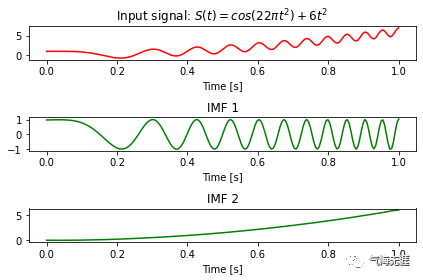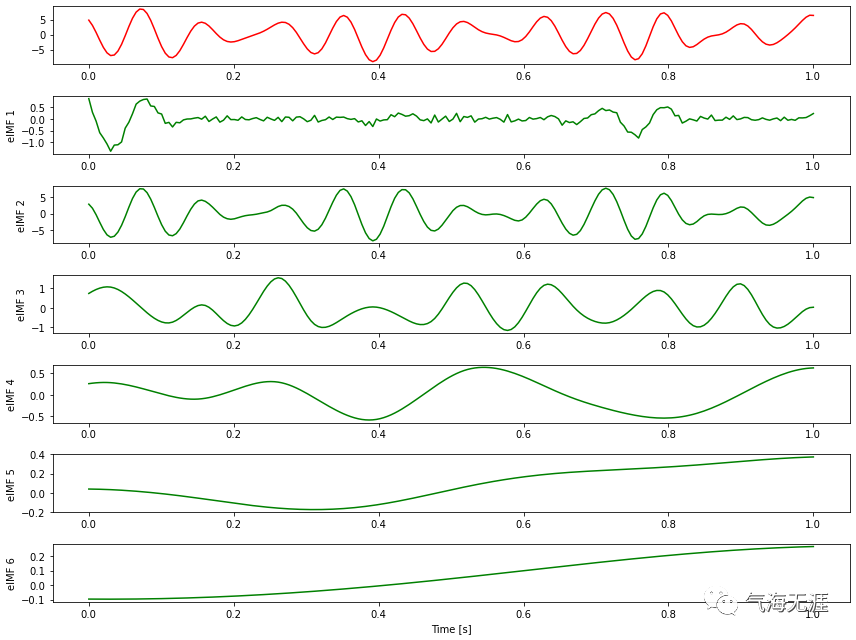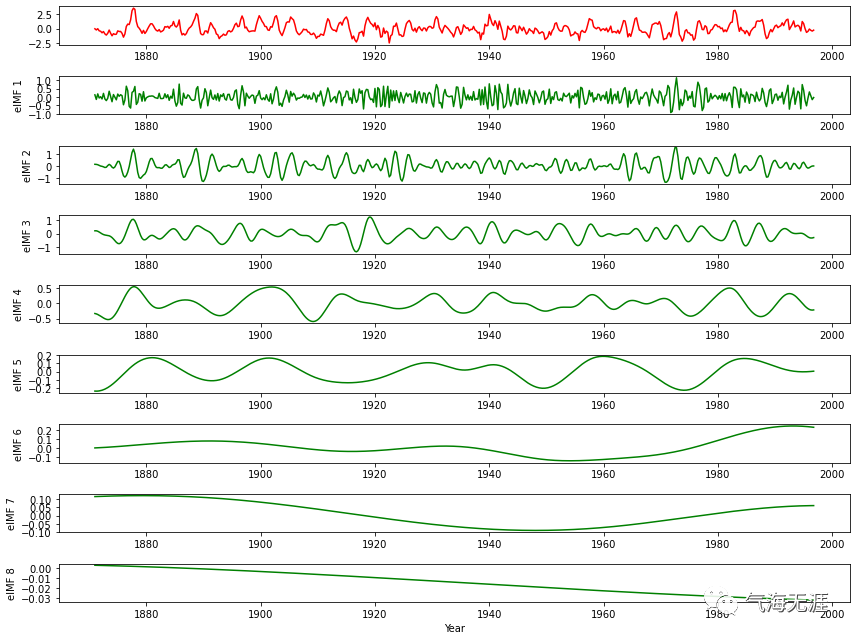
1、导入模块
1from PyEMD import EMD, EEMD
2from PyEMD.visualisation import Visualisation
3import numpy as np
4import pylab as plt
5
6import warnings
7warnings.filterwarnings('ignore')复制
2、经验模态分解(EMD)
相对于小波分解,EMD具有自适性、后验性,并能对信号进行平稳化处理,在气象要素分析及实际业务中被广泛应用,可用于发展新的预测方法和集合预报技术。EMD算法能将原始信号不断进行分解,获取符合一定条件下的IMF分量。这些 IMF 分量之间的频率往往不同,这就为其在谐波检测方向的使用提供了一种思路。
1# Define signal
2t = np.linspace(0, 1, 200)
3s = np.cos(11*2*np.pi*t*t) + 6*t*t
4
5# Execute EMD on signal
6IMF = EMD().emd(s,t)
7N = IMF.shape[0]+1
8
9# Plot results
10plt.subplot(N,1,1)
11plt.plot(t, s, 'r')
12plt.title("Input signal: $S(t)=cos(22\pi t^2) + 6t^2$")
13plt.xlabel("Time [s]")
14
15for n, imf in enumerate(IMF):
16 plt.subplot(N,1,n+2)
17 plt.plot(t, imf, 'g')
18 plt.title("IMF "+str(n+1))
19 plt.xlabel("Time [s]")
20
21plt.tight_layout()
22plt.show()
复制
3、集合经验模态分解(EEMD)
EMD 算法以其正交性、收敛性等特点被广泛用于信号处理等领域,但并不像小波分析或者神经网络那样,有固定的数学模型,因此它的一些重要性质仍还没有通过缜密的数学方法证明出。而且对模态分量 IMF 的定义也尚未统一,仅能从信号的零点与极值点的联系与信号的局部特征等综合描述。
EMD在信号分析中存在一定缺陷——尺度混合,导致分解在物理上不唯一,甚至失去意义。为了弥补尺度混合等问题,在其基础上发展了EEMD(Ensemble Empirical Mode Decomposition)。因此,EEMD即继承了EMD自适性等优点,又避免了尺度混合的缺陷。EEMD分解算法基于白噪声频谱均衡的分布特点来均衡噪声,使得频率的分布趋于均匀。添加的白噪声不同信号的幅值分布点带来的模态混叠效应。EEMD分解满足自适应性,其分解结果决定于资料长度本身,与分解次数无关。
1# Define signal
2t = np.linspace(0, 1, 200)
3
4sin = lambda x,p: np.sin(2*np.pi*x*t+p)
5S = 3*sin(18,0.2)*(t-0.2)**2
6S += 5*sin(11,2.7)
7S += 3*sin(14,1.6)
8S += 1*np.sin(4*2*np.pi*(t-0.8)**2)
9S += t**2.1 -t
10
11# Assign EEMD to `eemd` variable
12eemd = EEMD()
13
14# Say we want detect extrema using parabolic method
15emd = eemd.EMD
16emd.extrema_detection="parabol"
17
18# Execute EEMD on S
19eIMFs = eemd.eemd(S, t)
20nIMFs = eIMFs.shape[0]
21
22# Plot results
23plt.figure(figsize=(12,9))
24plt.subplot(nIMFs+1, 1, 1)
25plt.plot(t, S, 'r')
26
27for n in range(nIMFs):
28 plt.subplot(nIMFs+1, 1, n+2)
29 plt.plot(t, eIMFs[n], 'g')
30 plt.ylabel("eIMF %i" %(n+1))
31 plt.locator_params(axis='y', nbins=5)
32
33plt.xlabel("Time [s]")
34plt.tight_layout()
35plt.show()
复制
4、读取海温数据并预处理
1# url = 'http://paos.colorado.edu/research/wavelets/wave_idl/nino3sst.txt'
2# dat = np.genfromtxt(url, skip_header=19)
3dat = np.loadtxt('/home/mw/work/nino3sst.txt',skiprows=19)
4print(dat.shape)复制
输出:
1(504,)复制
变量赋值
1t0 = 1871.0 # 开始的时间,以年为单位
2dt = 0.25 # 采样间隔,以年为单位
3N = dat.size # 时间序列的长度
4t = np.arange(0, N) * dt + t0 # 构造时间序列数组复制
数据处理
1p = np.polyfit(t - t0, dat, 1) # 线性拟合
2dat_notrend = dat - np.polyval(p, t - t0) # 去趋势
3std = dat_notrend.std() # 标准差
4var = std ** 2 # 方差
5dat_norm = dat_notrend / std # 标准化复制
5、nino3海温距平数据的集合经验模态分解
1# Assign EEMD to `eemd` variable
2eemd = EEMD()
3
4# Say we want detect extrema using parabolic method
5emd = eemd.EMD
6#emd.extrema_detection="parabol"
7
8# Execute EEMD on S
9eIMFs = eemd.eemd(dat_norm, t)
10nIMFs = eIMFs.shape[0]
11
12# Plot results
13plt.figure(figsize=(12,9))
14plt.subplot(nIMFs+1, 1, 1)
15plt.plot(t, dat_norm, 'r')
16
17for n in range(nIMFs):
18 plt.subplot(nIMFs+1, 1, n+2)
19 plt.plot(t, eIMFs[n], 'g')
20 plt.ylabel("eIMF %i" %(n+1))
21 plt.locator_params(axis='y', nbins=5)
22
23plt.xlabel("Year")
24plt.tight_layout()
25plt.show()
复制
6、绘制IMF和瞬时频率
1imfs, res = eemd.get_imfs_and_residue()
2vis = Visualisation()
3vis.plot_imfs(imfs=imfs, residue=res, t=t, include_residue=True)
4vis.plot_instant_freq(t, imfs=imfs)
5vis.show()复制
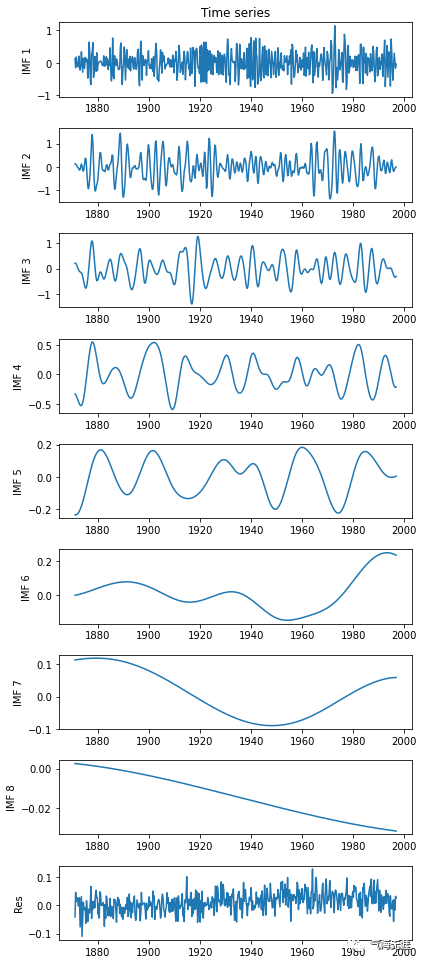
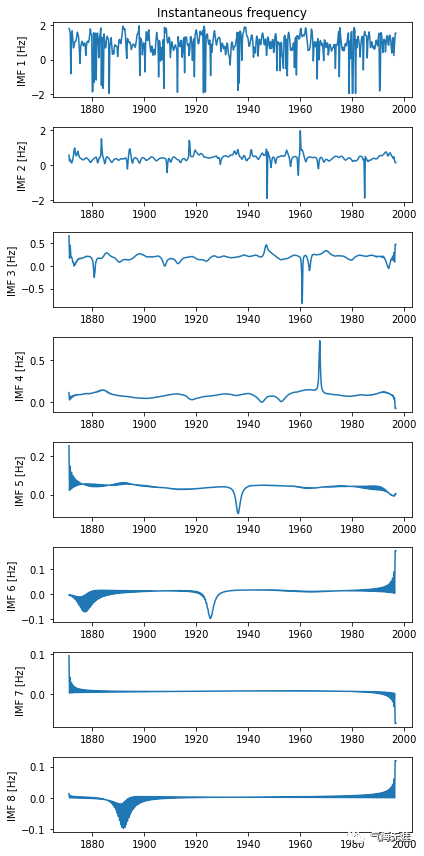
有问题可以到QQ群里进行讨论,我们在那边等大家。
QQ群号:854684131
文章转载自气海无涯,如果涉嫌侵权,请发送邮件至:contact@modb.pro进行举报,并提供相关证据,一经查实,墨天轮将立刻删除相关内容。






